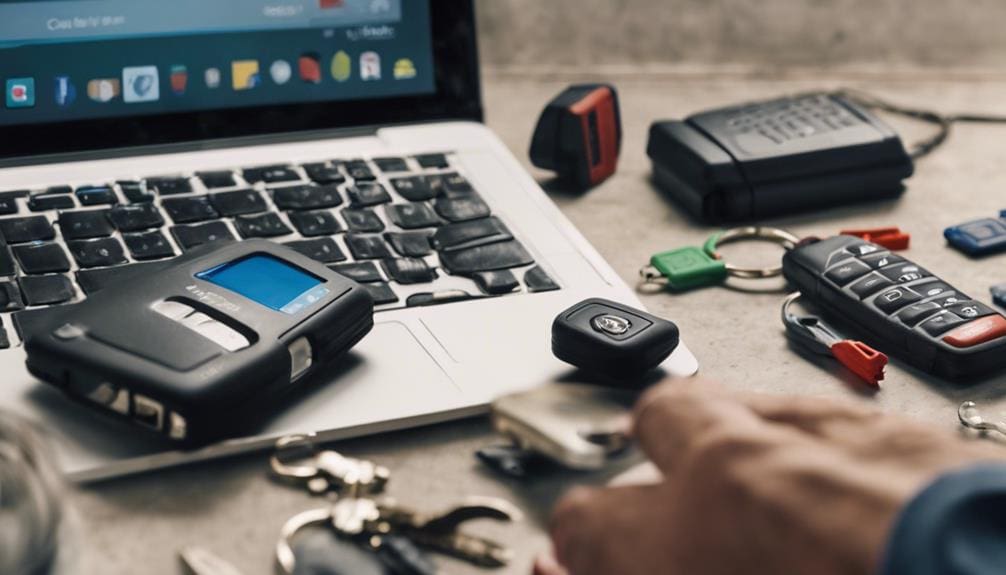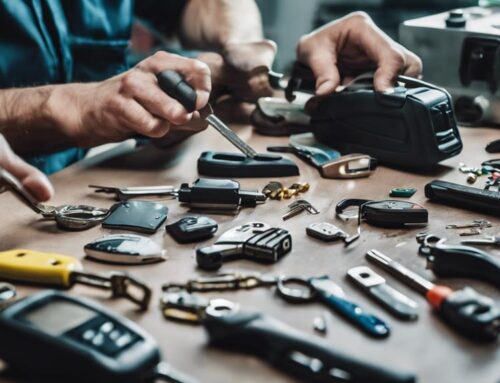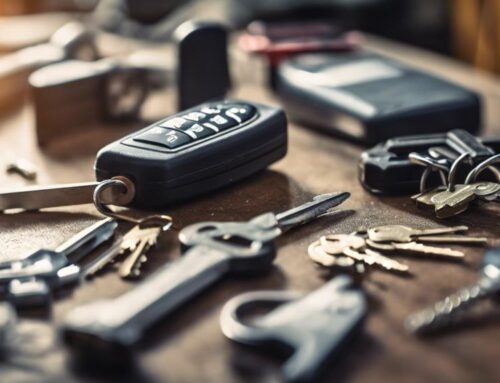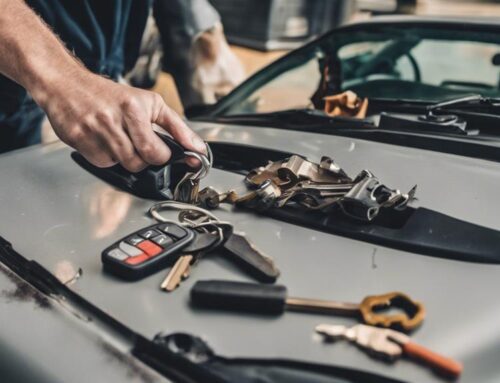You can program a new keyless entry remote yourself with the right tools and clear instructions. Start by sitting inside your vehicle with all doors closed and inserting the key into the ignition. Turn it to the ‘On’ position and press the ‘Lock’ button on the remote twice. Listen for the locks to cycle, indicating you’re in programming mode. Press and hold the ‘Lock’ and ‘Release’ buttons on the remote to finalize the process. Test the remote for all functions. If you’ve got the proper equipment and follow the steps precisely, it’s certainly feasible. Learn about tackling common challenges and ensuring success next.
Key Takeaways
- Many vehicles allow DIY keyless remote programming using specific sequences and steps.
- Basic tools like an OBD-II scanner and a laptop with suitable software are essential.
- Programming requires following precise instructions based on the vehicle’s make and model.
- Ensure the remote and vehicle batteries are fully charged for successful synchronization.
- Professional assistance may be necessary if DIY attempts fail or for complex systems.
Understanding Keyless Entry Systems
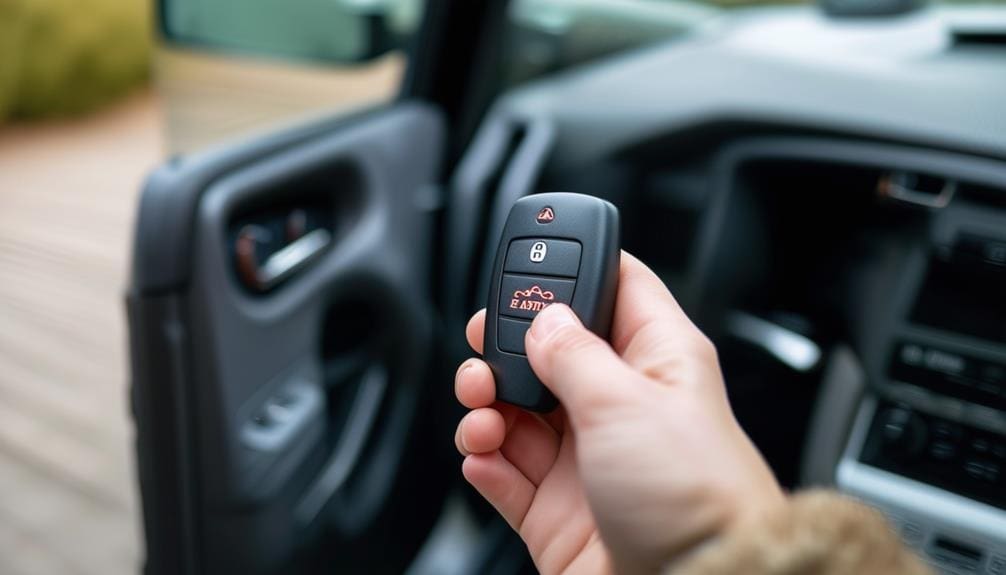
In order to grasp the fundamentals of keyless entry systems, you must first understand how these electronic devices communicate with your vehicle. Keyless entry systems use radio frequency (RF) signals to transmit commands from the remote to the vehicle. When you press a button on your remote, it sends a unique code via RF to a receiver unit inside your car. The receiver then decodes this signal and executes the corresponding action, such as opening doors or accessing the trunk.
You need to know that each remote and vehicle pairing involves a specific encryption algorithm to prevent unauthorized access. Modern keyless entry systems employ rolling codes, which change every time you use the remote. This guarantees that even if someone intercepts the signal, they can’t reuse it to gain access.
To establish this secure communication, both the remote and the vehicle’s receiver must be synchronized during the programming process. Understanding this synchronization is vital for effectively managing your keyless entry system. Mastering these technical details empowers you to maintain control over your vehicle’s security, making sure that only you and your authorized users can utilize it.
Assessing DIY Feasibility
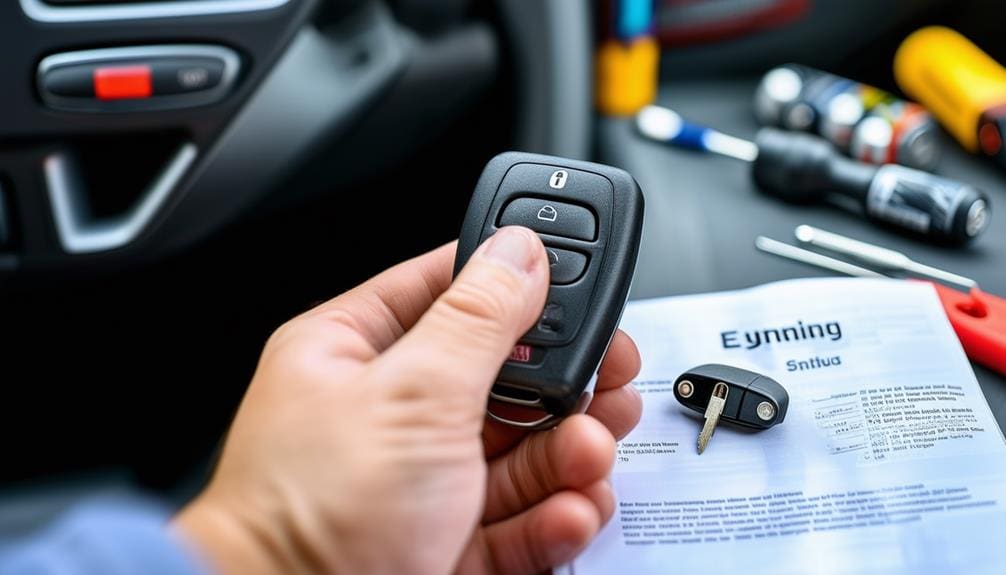
Before you start programming your keyless remote, evaluate the complexity of the process and make sure you have the required tools and equipment. Some vehicles need specialized diagnostic devices that might be expensive or hard to find. Check your vehicle’s manual and online resources to confirm whether a DIY approach is practical for your specific situation.
Complexity of Programming Process
Evaluating the DIY feasibility of programming a keyless remote requires understanding the specific steps involved and determining the necessary technical skills. The complexity of the process can vary considerably depending on the make and model of your vehicle. Some vehicles offer straightforward procedures that anyone can follow, while others demand advanced technical knowledge and specialized equipment.
To break down the complexity, consider the following factors:
| Criteria | Easy to Program | Complex to Program |
|---|---|---|
| Vehicle Make/Model | Common brands (e.g., Ford, GM) | Luxury brands (e.g., BMW, Audi) |
| Steps Involved | Few (3-5 steps) | Many (10+ steps) |
| Technical Skills | Basic (no prior experience) | Advanced (coding knowledge) |
| Documentation | Easily accessible manuals | Proprietary, hard to find |
Understanding these criteria will help you assess whether you can handle the programming yourself or if you should seek professional assistance. For example, if you own a common brand and the programming involves only a few steps, you might find it quite manageable. However, if your vehicle is a luxury brand and requires extensive steps including coding, professional help might be the prudent choice.
Required Tools and Equipment
Having gauged the complexity of the programming process, let’s now focus on the tools and equipment you’ll need to successfully program a keyless remote. First and foremost, you’ll need the new keyless entry remote itself. Make sure it’s compatible with your vehicle’s make and model.
Next, a functional transponder key is essential. This will allow you to access and modify your vehicle’s onboard diagnostics (OBD) system. Speaking of which, an OBD-II scanner or programmer is vital. This device interfaces with your vehicle’s computer, enabling you to program the new remote. Choose one with key programming capabilities.
You’ll also need a laptop or mobile device with the appropriate software installed. Some OBD-II scanners come with their own software, while others may require third-party applications. Make sure your device is fully charged or connected to a power source throughout the process.
A detailed user manual for your specific vehicle model can be invaluable. It will guide you through any unique steps required for your car. Finally, make sure you’ve got a stable internet connection to download any necessary updates or software.
Required Tools and Equipment
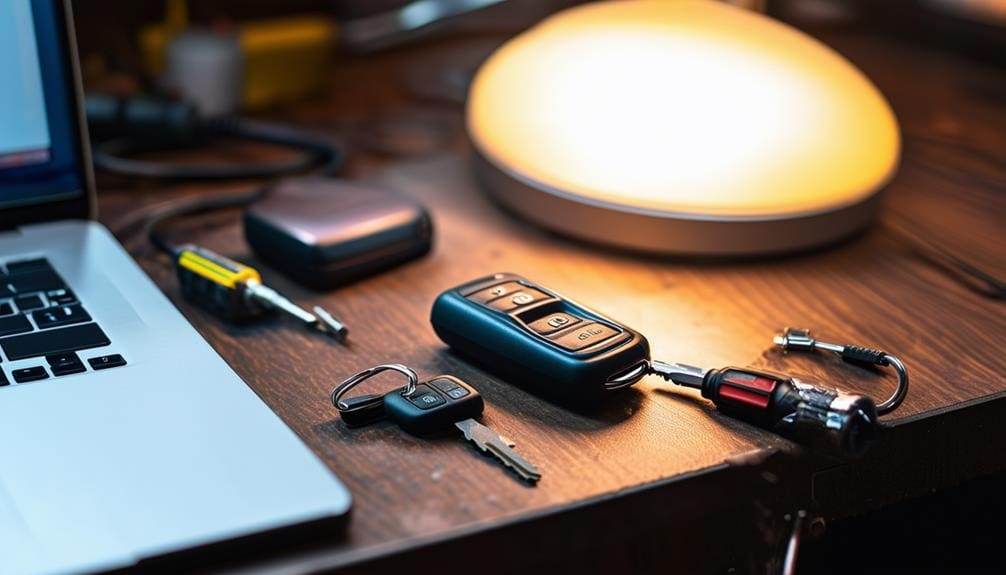
To program your keyless remote, you’ll need specific tools and equipment to guarantee success. Start with a reliable OBD-II scanner compatible with your vehicle model, and have a fresh set of batteries for the remote. Make sure to follow an essential equipment checklist, including a user manual and any necessary software updates.
Necessary Programming Tools
You’ll need a diagnostic scan tool capable of interfacing with your vehicle’s onboard computer to successfully program a keyless remote. This tool allows you to access the vehicle’s electronic control units (ECUs), which is essential for linking the new remote to your car’s system. Confirm the scan tool is compatible with your vehicle make and model; not all diagnostic tools are universal.
Next, secure a reliable OBD-II cable, which connects the scan tool to the vehicle’s OBD-II port. This port is typically located under the dashboard, near the driver’s seat. A high-quality cable ensures stable and accurate data transmission, which is critical for successful programming.
You’ll also need a laptop or a mobile device with the appropriate software installed. Many diagnostic tools require specific software applications to perform keyless remote programming. Verify your device’s operating system is compatible with the software to avoid operational hiccups.
Essential Equipment Checklist
For efficient keyless remote programming, make sure you have a diagnostic scan tool, an OBD-II cable, and a compatible laptop or mobile device with necessary software installed. These tools are essential. The diagnostic scan tool will communicate with your vehicle’s onboard computer, while the OBD-II cable connects this tool to your vehicle. Confirm your laptop or mobile device is equipped with the correct software; without it, you won’t be able to access the vehicle’s keyless entry system.
Next, gather any specific programming instructions for your vehicle make and model. Manufacturers often have unique processes, so having this information is vital. Additionally, have a fully charged battery in your vehicle and your keyless remote. A weak battery can interrupt the programming sequence, rendering your efforts futile.
Consider a backup power source for your laptop or mobile device. Losing power mid-programming can corrupt data and complicate the process. Lastly, a stable internet connection is necessary for downloading any software updates or additional instructions. With these tools and resources at your disposal, you’re well-equipped to take control of your vehicle’s keyless entry system and complete the programming successfully.
Step-by-Step Programming Guide
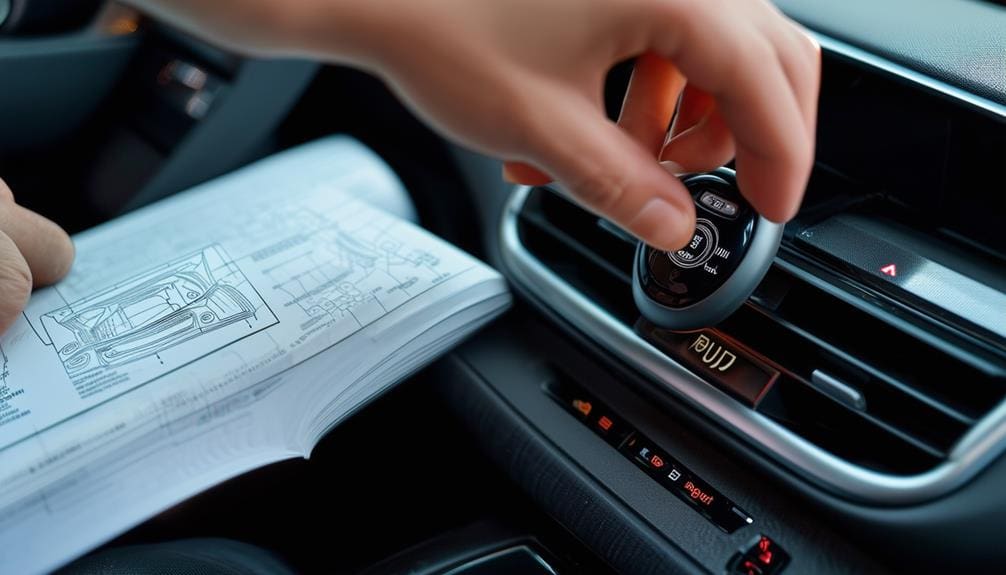
Begin by sitting inside your vehicle with all doors closed and the keyless remote in hand. Make sure that you have all necessary equipment from the checklist. Insert your key into the ignition and turn it to the ‘On’ position without starting the engine.
Next, within five seconds, press and hold the ‘Lock‘ button on your remote for one second, then release. Turn the ignition back to the ‘Off’ position. Repeat this process three more times, ending with the key in the ‘On’ position. At this point, you should hear the locks cycle, indicating the vehicle has entered programming mode.
Immediately press and hold the ‘Lock’ and ‘Release’ buttons on your remote simultaneously for about 15 seconds. Release both buttons and wait for the locks to cycle again, which confirms successful programming.
Turn the ignition to the ‘Off’ position and remove the key. Open and close the driver’s door to exit programming mode. Test the remote to make sure all functions—lock, release, trunk release—are working correctly.
Repeat the above steps for additional remotes if necessary. Remember, precision and timing are essential for successful programming, so follow each step meticulously.
Common Challenges and Solutions
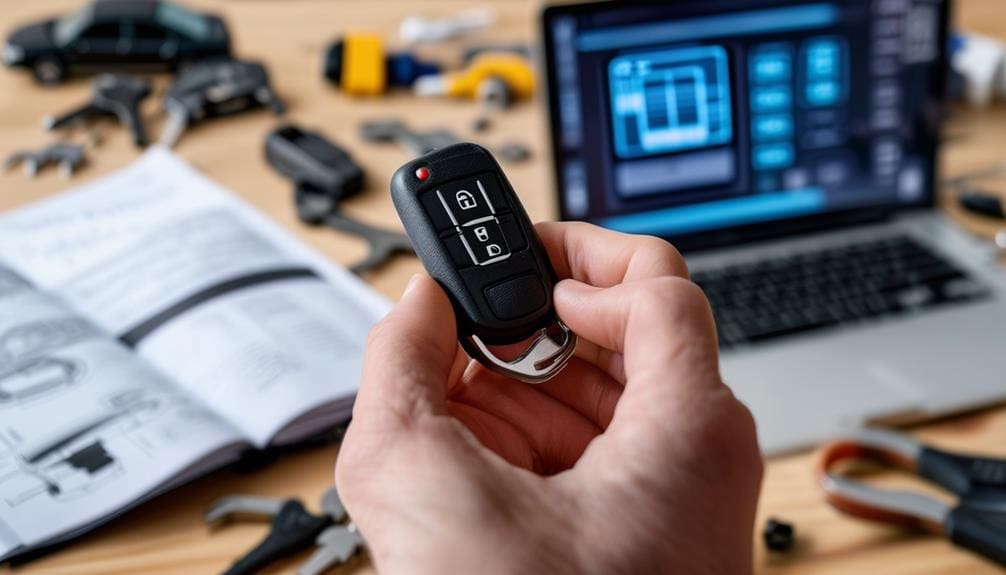
Encountering issues during keyless remote programming is common, but understanding their root causes can greatly simplify troubleshooting. One frequent problem is a non-responsive remote, often due to a drained battery or improper synchronization with your vehicle. Confirm you’re using a compatible remote and follow the programming steps meticulously. If the vehicle doesn’t enter programming mode, check the door locks and ignition switch for proper functionality. Sometimes, interference from other electronic devices can disrupt the process; try programming away from such disturbances.
Below is a table summarizing common challenges and their solutions:
| Challenge | Cause | Solution |
|---|---|---|
| Remote not responding | Depleted battery | Replace battery with a fresh, compatible one |
| Vehicle not entering programming | Faulty door locks or ignition switch | Inspect and repair door locks or ignition switch |
| Inconsistent signal | Electronic interference | Move to a different location |
| Remote not compatible | Incompatible remote model | Verify compatibility with vehicle |
| Failed synchronization | Incorrect programming steps | Recheck and follow the programming instructions |
Benefits of Professional Programming
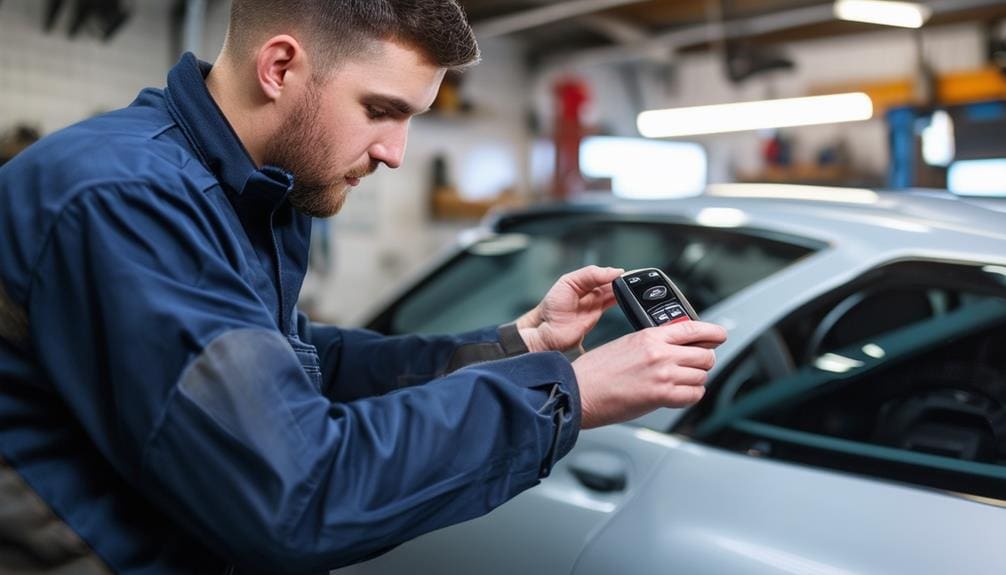
Selecting professional programming ensures that your keyless remote is accurately synchronized with your vehicle, reducing the chances of operational issues. Professionals possess specialized tools and software that guarantee each remote command is precisely paired with your car’s unique system. This prevents malfunctions that could jeopardize your vehicle’s security or leave you locked out.
Relying on experts also means they can diagnose and resolve any underlying issues with your vehicle’s electronic systems. If your car’s computer interface or signal receptors encounter problems, a professional can identify and fix these before programming the remote. This proactive troubleshooting spares you from potential headaches in the future.
Furthermore, professional programming often includes a warranty or guarantee, providing you with peace of mind. If anything goes wrong, you can return to the service provider for assistance, ensuring your remote remains dependable and trouble-free.
Professionals also stay updated with the latest advancements in automotive security technology. By opting for their services, you benefit from the most current and effective programming methods available. This guarantees your vehicle remains secure, giving you control and confidence on the road. Choosing expert programming is a strategic decision that maximizes the functionality and reliability of your keyless entry system.
Frequently Asked Questions
How Can I Tell if My Car Supports DIY Keyless Remote Programming?
To determine if your car supports DIY keyless remote programming, consult your owner’s manual or contact the manufacturer. Look for specific instructions on remote programming capabilities. If available, follow the detailed steps provided.
What Are the Security Risks of Programming My Own Keyless Entry Remote?
Programming your own keyless entry remote can expose your vehicle to unauthorized access if not done correctly. Hackers could exploit weak encryption or cloning vulnerabilities, so make sure you use secure methods and keep firmware updated for protection.
Can I Use a Used Keyless Remote From a Different Vehicle?
Using a used keyless remote from another vehicle is like fitting a square peg in a round hole. It likely won’t work due to frequency mismatches and security protocols. Always check compatibility and reprogramming instructions meticulously.
How Do I Properly Dispose of an Old or Faulty Keyless Remote?
To properly dispose of an old or faulty keyless remote, remove the battery and recycle it separately. Then, take the remote to an electronic waste disposal center. Don’t throw it in regular trash to avoid environmental harm.
Are There Specific Brands or Models That Are Easier to Program Than Others?
Oh, so you think you’re up for the challenge? Some brands like Ford and Toyota make it easier with their user-friendly interfaces. Just follow the manual like a tech-savvy wizard, and you’ll conquer remote programming effortlessly.
Conclusion
You’ve followed the steps, gathered the tools, and conquered the challenges. But did it work? Imagine the thrill when your new keyless entry remote functions flawlessly. You’ve just saved time and money, proving that with the right guidance, you can tackle even the most technical tasks. If it didn’t work, don’t worry—professional help is always available. But for now, enjoy the satisfaction of a job well done. What might you tackle next?

